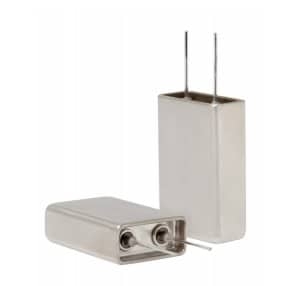source: Electronics 360 news
Source: Cornell Dubilier 20 June 2017
The MLSH hermetically-sealed flatpack aluminum electrolytic capacitor. For more than 20 years, flatpack aluminum electrolytic capacitors have been used for military and aerospace applications such as radar, cockpit communications, aircraft power supplies, black boxes and much more.Seen as an alternative to wet tantalum capacitors, flatpack aluminum electrolytic have excellent capacitance retention at low temperature. They are rugged and can withstand high altitudes making them especially well-suited for aerospace and military use.
While flatpack capacitors have a tight seal, some military-aerospace designers avoid using any type of aluminum electrolytic capacitor because they tend to lose electrolyte over time, through outgassing, resulting in dry-out—something that adversely changes the electrical properties of the capacitor.
The advent of a hermetically-sealed option has given these discrete components the ability to prevent dry-out. About 9 or 10 months ago, Cornell Dubilier introduced what it claims is the only hermetically-sealed aluminum electrolytic capacitor, type MLSH Slimpack, offering true glass-to-metal seal that results in no electrolyte loss and no dry-out.
“Wet tantalums have been used for about 40 years and fears of dry-out in critical space and military applications have kept aluminum electrolytic capacitors on the sidelines,” says Scott Franco, director of market development at Cornell Dubilier. “We now have found a way to prevent dry-out while providing all the benefits of electrolytic technology in a hermetic package. It is a game changer for next-generation aerospace and military applications.”
Generally, aerospace applications require a minimum capacitance at a low temperature. Hermetically-sealed electrolytic capacitors feature a better retention a low temperatures compared to wet tantalum capacitors, Franco says. With an ultra-long lifespan, the ability to handle 80g’s of vibration, the technology could replace banks of wet tantalum capacitors in designs. One aluminum electrolytic capacitor takes the place of three or four wet tantalums to provide the same capacitance at low temperature, he says.
“This saves on space, saves on cost and saves on weight,” Franco says. “Something that every engineer and designer is looking for in the aerospace and military field.”
With less components in a system it also increases reliability. With multiple components, the greater the risk of any one of those components failing or one of those connection points failing. Reliability goes up when replacing multiple components with a single discrete component.
Cornell Dubilier is targeting next-generation military and aerospace designs focusing on aircraft and equipment that is two to three years down the road. Although the company hasn’t ruled out that the hermetically-sealed aluminum electrolytic capacitors could be used in current designs looking to upgrade.
Future iterations of aluminum electrolytic capacitors may be applicable for space, Cornell Dubilier knows the devices can withstand the harsh conditions of space but they require more energy density than what is currently offered and have not yet released a standard product for space as of yet.
“We didn’t’ really target space specifically, but we do have the technology and capability to meet space applications,” Franco says.































